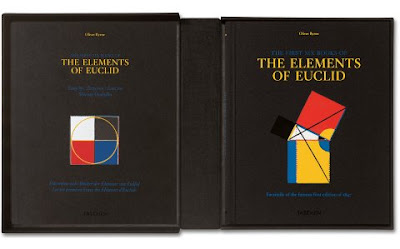Friday, October 8, 2010
Byrne, Six Books of Euclid
Red, yellow, blue – and of course black – are the colours that Oliver Byrne employs for the figures and diagrams in his most unusual 1847 edition of Euclid, published by William Pickering and printed by Chiswick Press, and which prompt the surprised reader to think of Mondrian. The author makes it clear in his subtitle that this is a didactic measure intended to distinguish his edition from all others: "The Elements of Euclid in which coloured diagrams and symbols are used instead of letters for the greater ease of learners." Byrne is not content to trust solely in the supposed intuitive "logical" structure of Euclid's axioms and theorems – who doesn't know the first famous sentences of Euclid's Elements: "I. A point is that which has no parts. II. A line is length without breadth"? –, but translates them into colourful diagrams and symbols. He thereby thinks in terms of the school classroom: he compares his colours to the dyed chalks in which figures are drawn on the blackboard.
Labels:
Book,
Byrne,
Six Books of Euclid,
taschen
Subscribe to:
Post Comments (Atom)


No comments:
Post a Comment